Stunning Tan House Color Schemes That Elevate Curb Appeal
Tan homes are like a blank canvas—neutral, inviting, and wonderfully versatile. I discovered this the hard way after moving into a tan-sided house that somehow managed to look both plain and mismatched depending on the light. What I quickly learned was that tan isn’t boring—it’s strategic. With the right supporting colors, it can go from forgettable to fantastic.
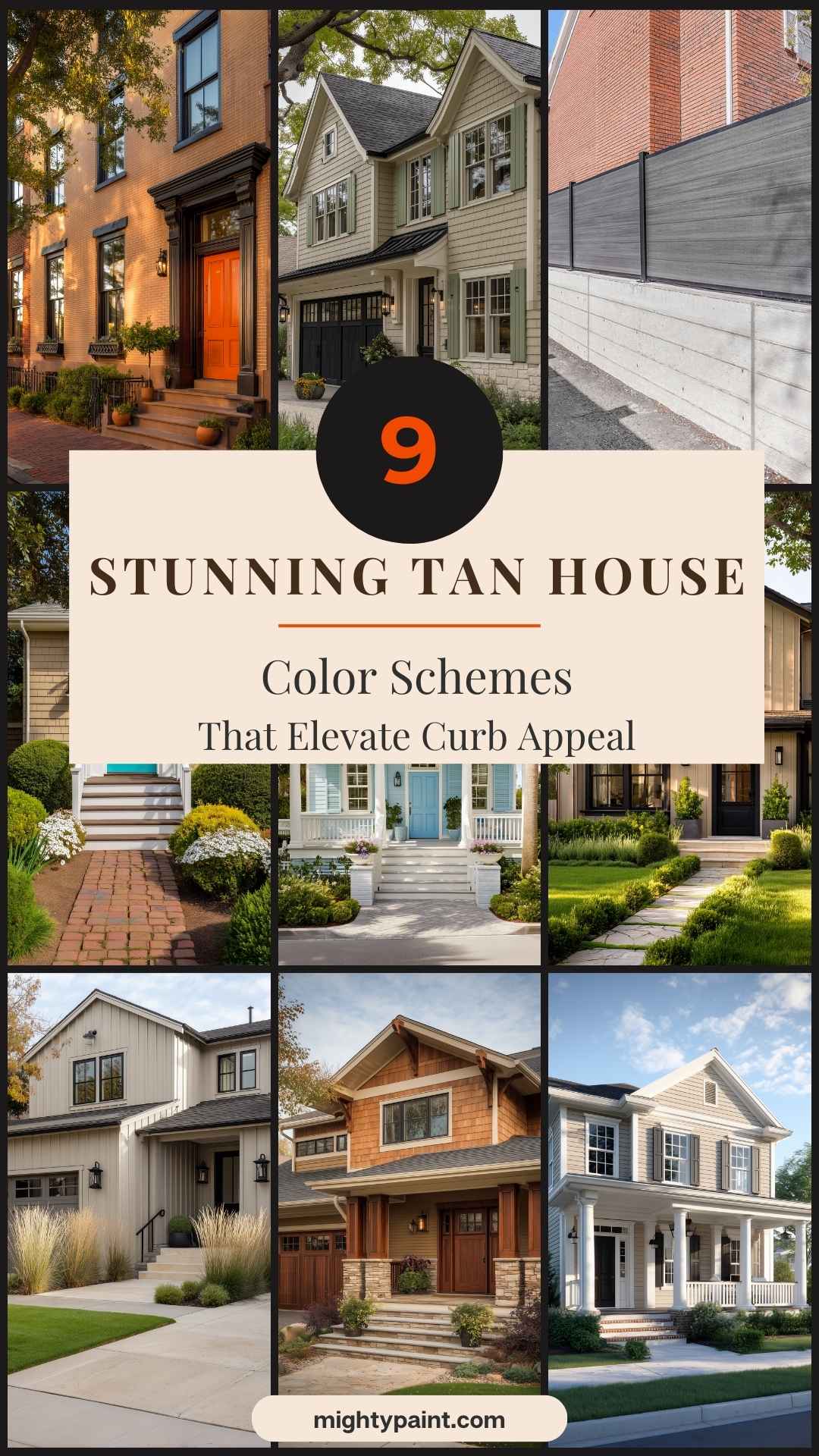
Whether you’re aiming for crisp contrast or subtle sophistication, choosing the right color palette to complement tan siding can transform your entire exterior. It’s not just about paint—it’s about pairing shades that highlight your home’s features, harmonize with landscaping, and set the right mood from the curb.
Get the Fail-Safe Paint Color Playbook (Free PDF)
36 proven colors • 8 ready palettes • trim & sheen guide • printable testing cards.
In this guide, I’ll walk you through 9 of the most eye-catching tan house color schemes. You’ll get real-world combos that work—from classic white trim to bold black shutters, warm wood tones to unexpected pops of teal. Each one is designed to work with the undertones you already have, not fight them. Let’s give your tan home the kind of character that turns heads.
Why Tan Exteriors Remain a Popular Canvas
Tan has long been a go-to exterior color because of its flexibility and easy charm. It strikes a balance between warm and neutral, offering a welcoming presence without feeling bold or overpowering. From modern farmhouses to traditional colonials, tan works across architectural styles and regions.
What really makes tan special is how effortlessly it plays with other colors. Pair it with crisp white and you get a clean, classic aesthetic. Lean into deeper tones like black or navy, and suddenly your home feels sophisticated and dramatic. Earth tones like sage or terracotta create harmony with surrounding landscapes, while bolder accents like teal or burnt orange give tan a fresh twist.
The beauty of tan is also in the way it complements natural materials. Stone facades, wooden shutters, and clay tiles all find a comfortable partner in tan siding. It’s a color that adapts rather than demands—making it one of the most versatile backdrops in exterior design.
Understand Your Undertone
Not all tans are created equal. Some lean warm, pulling in notes of gold or peach. Others feel cool and muted, veering toward greige or taupe. That’s why choosing accent colors isn’t just about contrast—it’s about matching undertones.
Here’s how to get it right:
- Look at your siding in natural daylight, not just under store lights or phone filters.
- Examine how the tan looks at different times of day. Morning light can make cool tans feel warmer, while evening sun may exaggerate yellow or red tones.
- Compare it to your home’s fixed features—like brickwork, roof color, or stone paths—to see if it complements or clashes.
A cool gray-green trim may look stunning with a neutral taupe-based tan, but awkward next to a peach-toned one. The more carefully you observe the undertone, the easier it becomes to choose colors that feel intentional and well-balanced.
9 Tan House Color Schemes
Tan might seem simple on the surface, but it offers surprising depth and adaptability when paired with the right colors. Whether your tan leans warm and golden or cool and muted, these curated schemes are designed to enhance its best traits—not fight them. Here’s how to make tan truly stand out.
1. Tan + Crisp White Trim
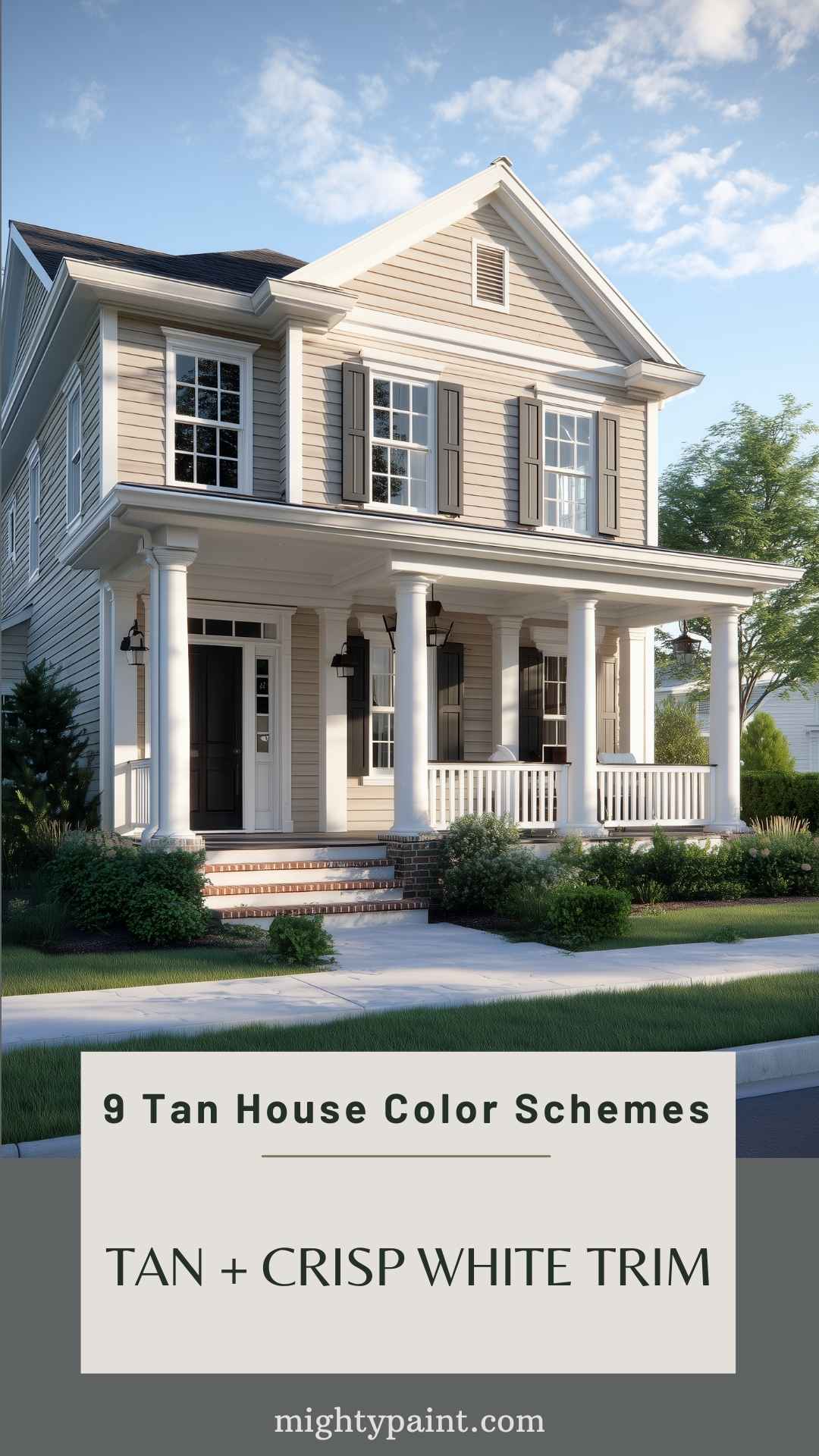
This is the timeless pairing that never fails. Crisp white trim against tan siding creates an airy, fresh exterior that feels both welcoming and refined. It works across home styles—from traditional colonials to updated ranches.
What makes this combo so effective is contrast. The sharpness of bright white outlines doors, windows, and rooflines with definition, giving your home a clean silhouette that pops without being loud.
This palette is also incredibly forgiving. You can play up classic accents like black shutters or add soft green planters without disrupting the balance. It also works well with most roof colors—from dark charcoal to warm brown shingles.
Tips to Get It Right:
- Choose a slightly warm white (like Sherwin-Williams’ “Alabaster”) to avoid clashing with the warmer tones of tan.
- Keep white trim coverage around 70% of accent areas (frames, fascia, porch railings) for clean cohesion.
This pairing may be common, but it’s common for a reason—it’s effortlessly stylish and always in good taste.
Get the Fail-Safe Paint Color Playbook (Free PDF)
36 proven colors • 8 ready palettes • trim & sheen guide • printable testing cards.
2. Tan + Deep Charcoal or Black Accents
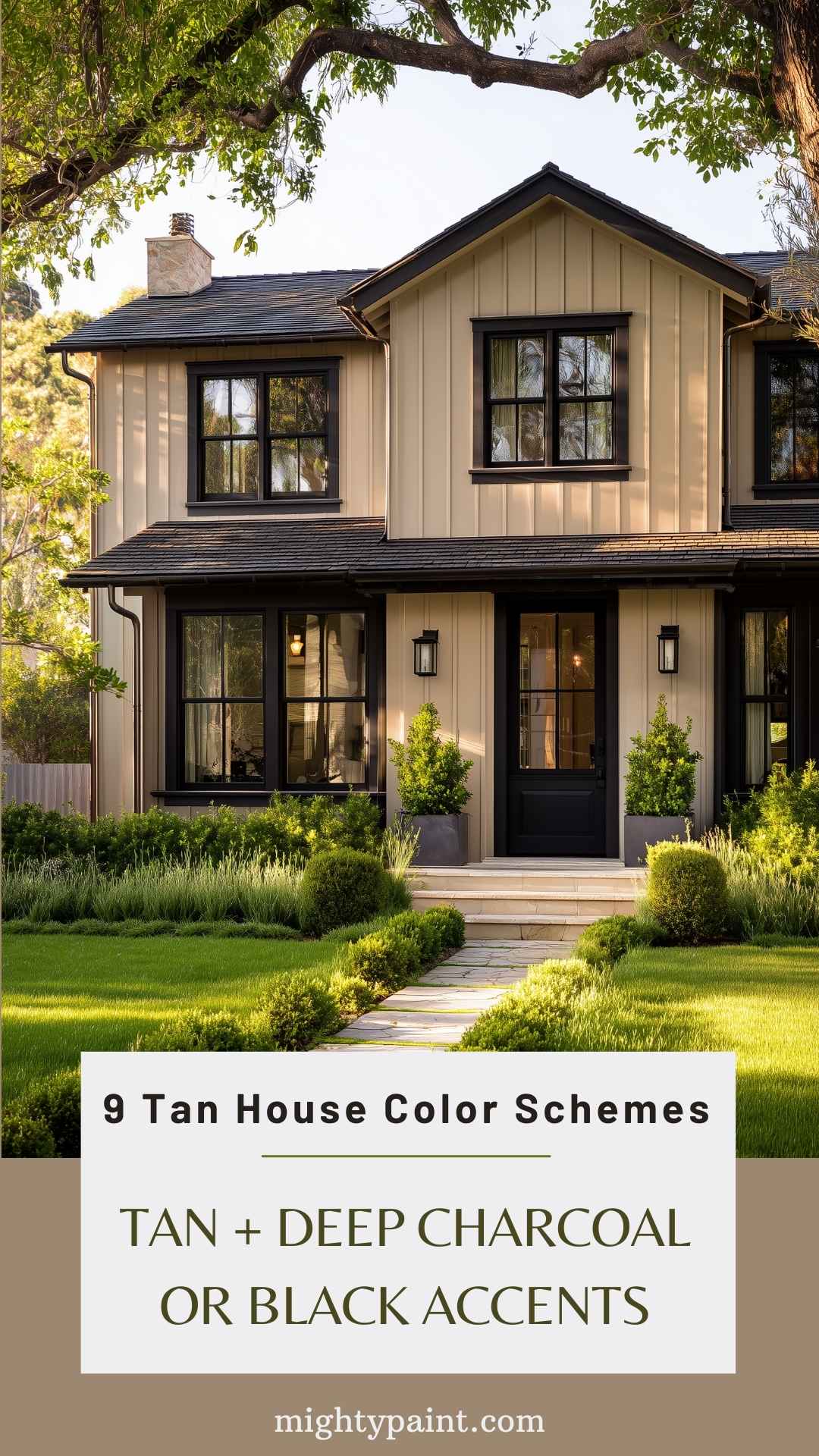
If you’re after something bold and dramatic, deep charcoal or true black against tan is a showstopper. The rich, dark accents ground the tan and give your home a modern, tailored look. Think contemporary farmhouse or urban colonial—sharp lines, strong contrast, undeniable presence.
This combo is best reserved for homes with some architectural detail to highlight. Use black on shutters, doors, and window frames—not the entire trim—so it adds drama without feeling oppressive.
Why It Works:
- Tan’s warmth balances black’s intensity.
- The contrast draws attention to features like gables, trim work, and window design.
To keep the look intentional, pair with matte black hardware and lighting fixtures for a coordinated feel. In landscape design, add darker mulch or deep green hedges to echo the dark tones and complete the picture.
Balance Tip:
Use black or charcoal on no more than 15% of the exterior. Let tan do most of the talking, with black as the punctuation mark.
3. Tan + Navy or Blue-Grey Shutters
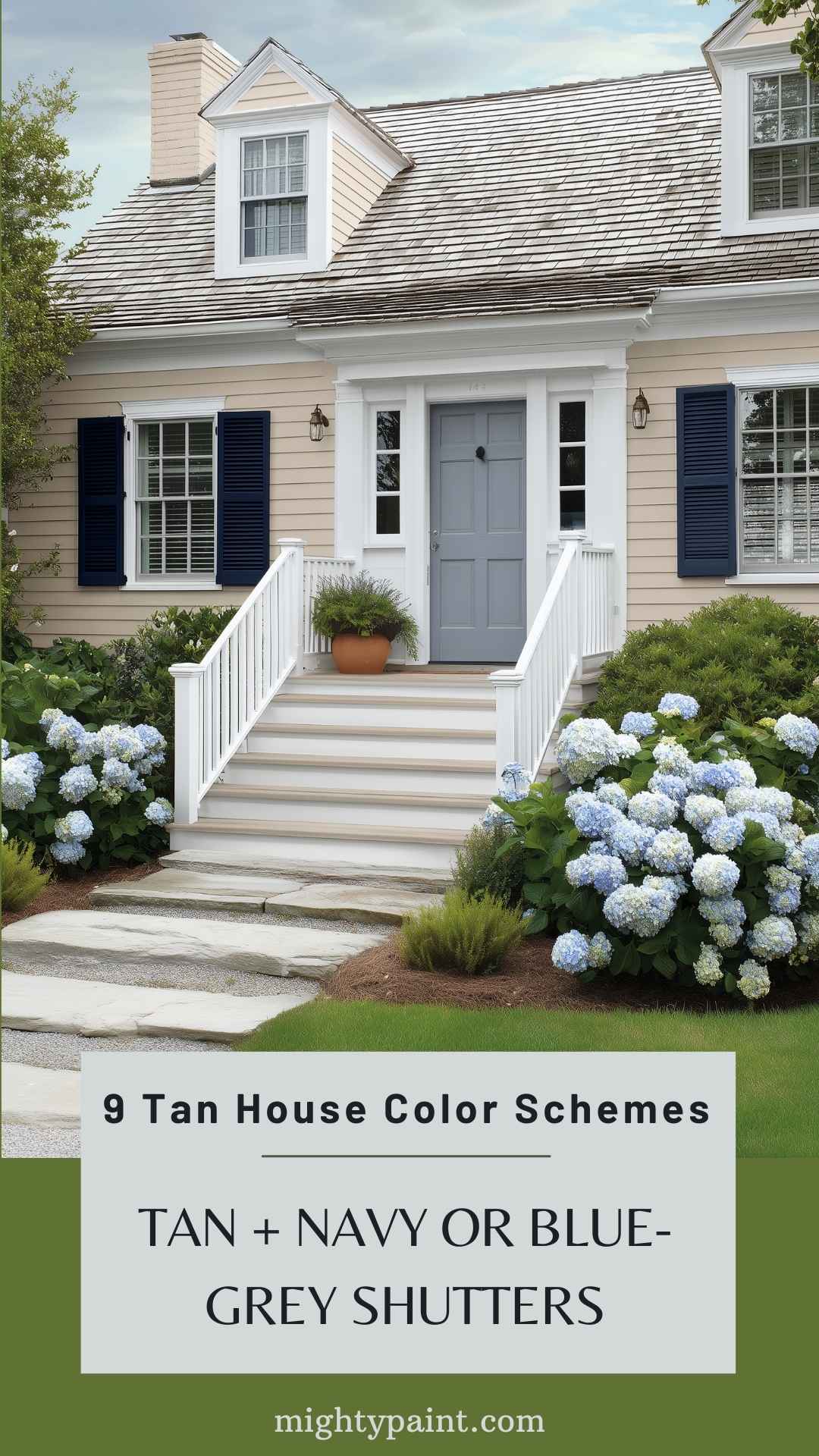
For a more coastal or calm look, navy and blue-greys bring in a soothing, classic feel. These colors subtly cool down tan’s warmth and add depth without being as stark as black. It’s a softer contrast that still feels refined.
This combination is a natural fit for Cape Cod or beach-style homes, but it also looks stunning on Craftsman exteriors or newer builds with neutral stone or brickwork.
Design Advantages:
- Navy adds richness and makes tan feel fresher.
- Blue-grey tones complement natural materials like flagstone or slate.
You can apply this color to shutters, front doors, or even porch ceilings (hello, Southern tradition!). For a slightly updated take, try a desaturated navy—almost a deep denim—which brings character without overwhelming the palette.
Design Tip:
Stick to using navy or blue-grey on about 25% of your accent surfaces—too much can cool the house too much and clash with warm-toned roofing or stone.
This pairing brings balance—warm meets cool, bold meets classic—and creates curb appeal that feels both timeless and on-trend.
Get the Fail-Safe Paint Color Playbook (Free PDF)
36 proven colors • 8 ready palettes • trim & sheen guide • printable testing cards.
4. Tan + Forest or Sage Green
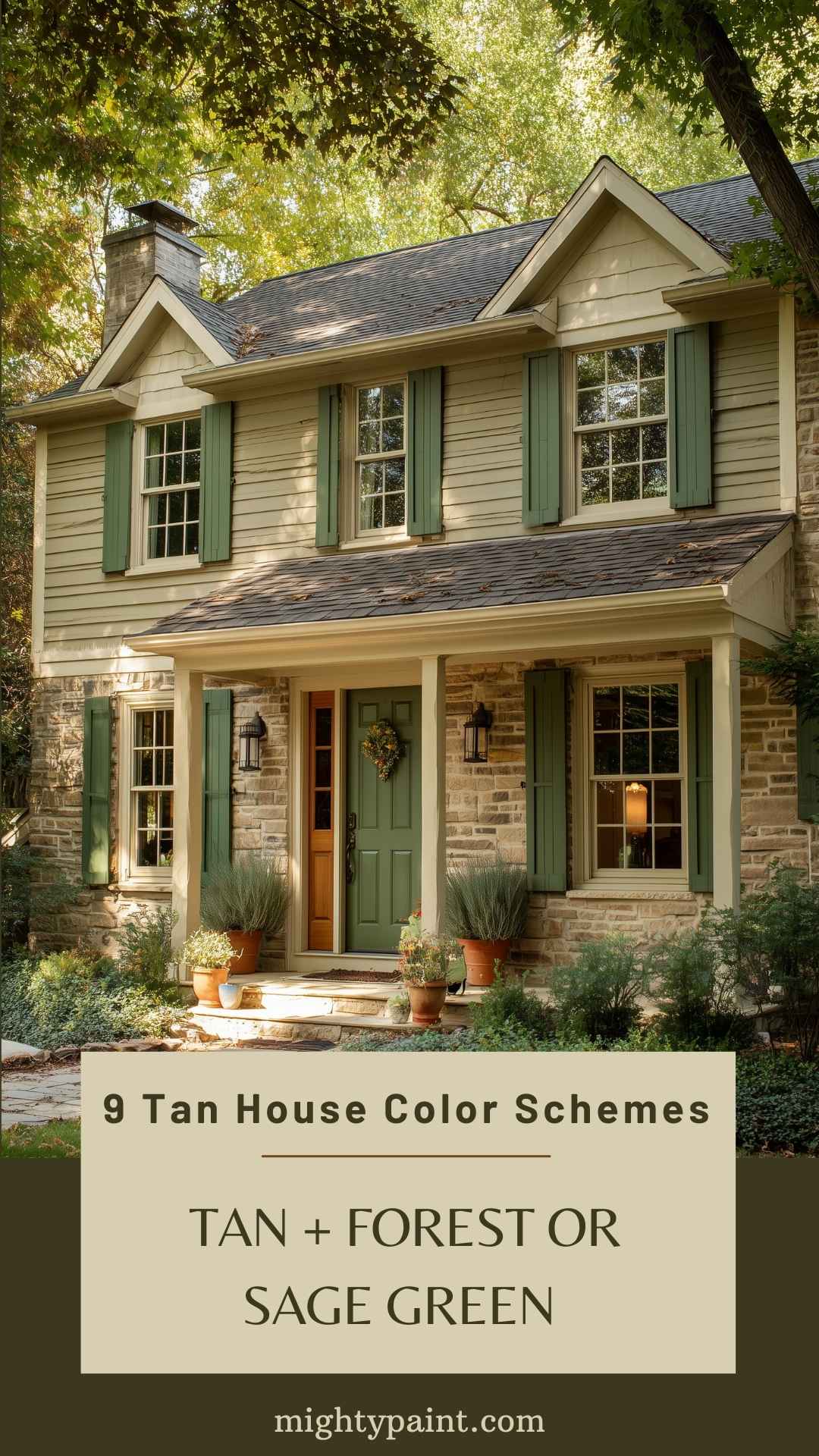
Green tones feel right at home alongside tan exteriors. Whether you choose a deep forest green or a soft sage, the pairing evokes a calming, organic feel that blends beautifully with natural surroundings. It’s a perfect match for suburban homes with mature trees or rustic houses set in wooded landscapes.
Sage green works especially well with cooler tans or those with a grayish undertone. Forest green, meanwhile, pairs better with richer, golden-leaning tans and adds bold contrast without the starkness of black.
Where to Use It:
- Shutters, gables, and porch columns
- Accent doors or window trim
- Garden fencing or mailbox posts
To complete the look, add clay planters, wrought iron furniture, or river rock in your landscaping. This scheme feels grounded and timeless without losing personality.
Tone Tip: Pick green shades with a slight gray base—this keeps the palette modern and prevents it from veering too rustic or minty.
5. Tan + Terracotta or Burnt Orange
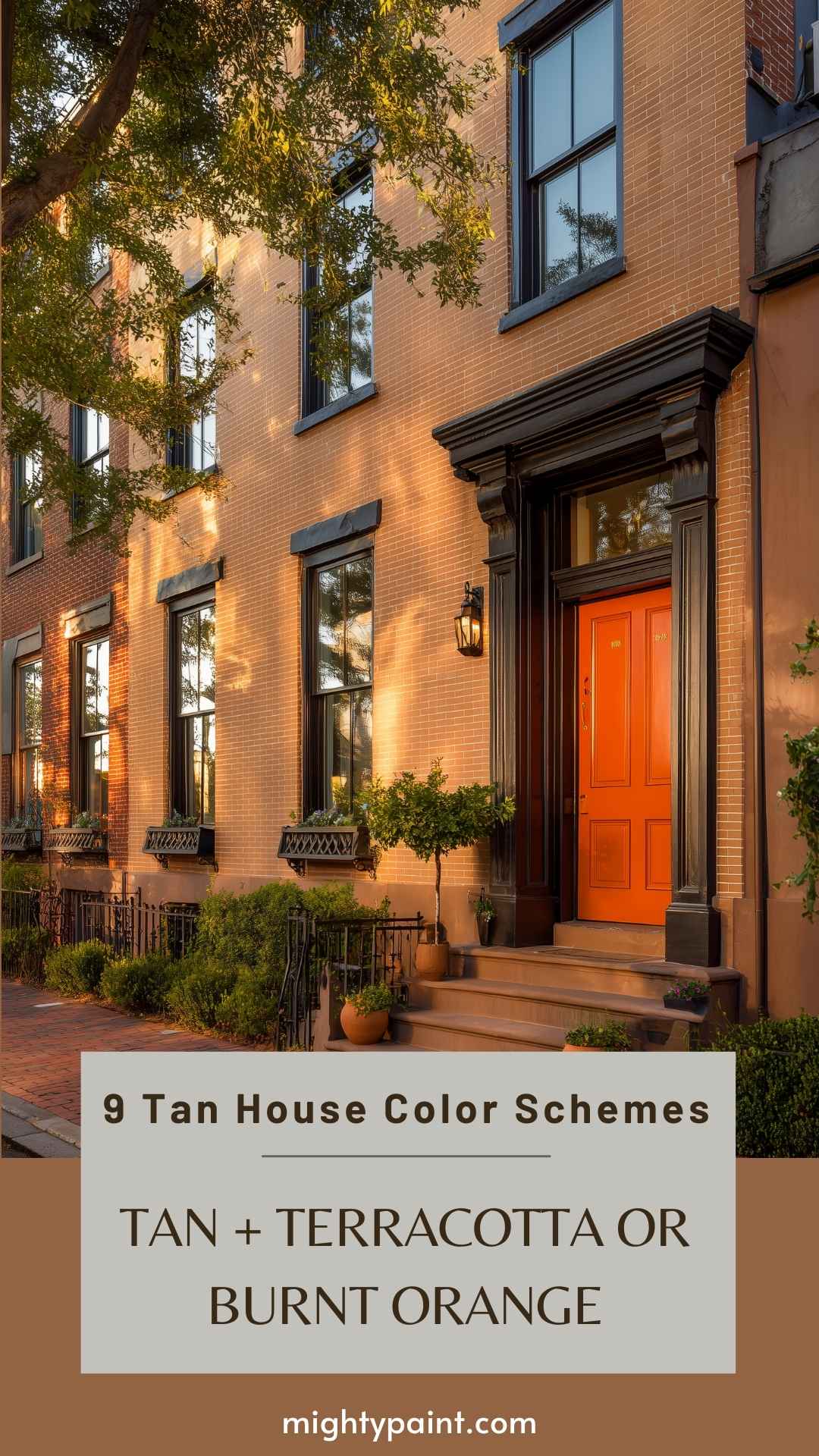
If you’re drawn to warmer, more Mediterranean vibes, terracotta or burnt orange accents can elevate tan into something bold and sun-drenched. These rich earthy hues bring out the golden undertones in tan siding, making the whole house glow—especially in warm climates or desert landscapes.
This combination is ideal for homes with stucco, Spanish tile roofing, or exposed wood beams. It offers a casual, almost coastal or Southwestern look that feels both lived-in and artistic.
Where It Shines:
- Front doors, window trim, porch beams
- Clay tile accents or brick walkways
- Rooflines and outdoor accessories
Just don’t overdo it—use burnt orange as a supporting accent, not a dominant color. A little warmth goes a long way.
Get the Fail-Safe Paint Color Playbook (Free PDF)
36 proven colors • 8 ready palettes • trim & sheen guide • printable testing cards.
Design Tip: Complement the look with dark bronze fixtures and warm-colored landscaping—lavender, agave, and red-blooming plants echo the desert vibe.
6. Tan + Red-Brown or Walnut Wood
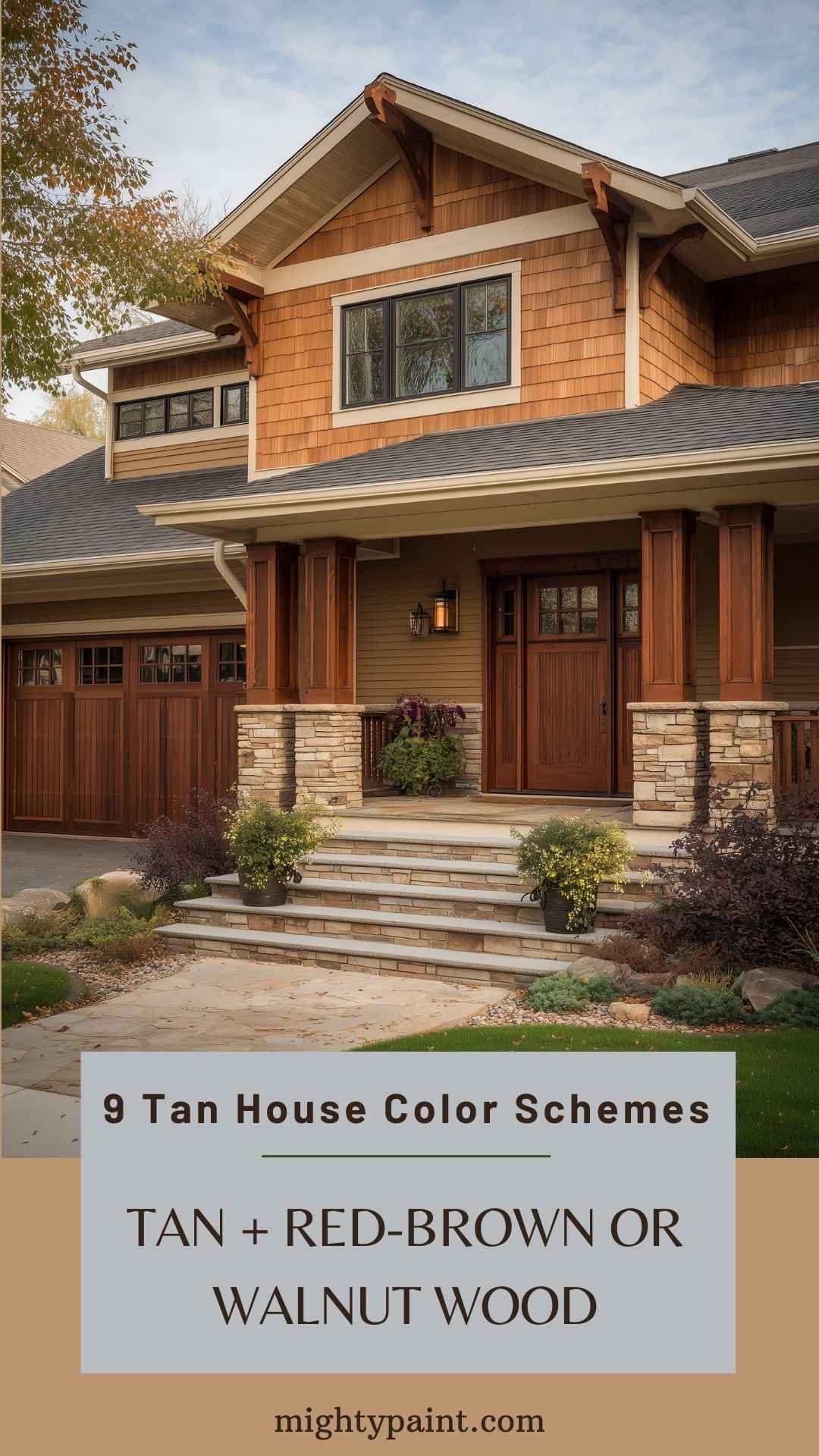
Natural wood tones and tan are practically made for each other. The richness of walnut or red-brown wood adds depth and texture to tan siding, creating a sophisticated and welcoming exterior. It’s especially effective on homes with exposed beams, covered porches, or farmhouse detailing.
This color scheme is about material contrast as much as color. Wood brings a tactile element—texture, grain, and warmth—that breaks up the monotony of painted surfaces.
Best Wood Features to Highlight:
- Garage doors and front doors
- Porch railings and columns
- Soffits, eaves, and corbels
This palette works beautifully with stone veneers and warm metal finishes like oil-rubbed bronze or antique brass.
Style Note: Choose stains with reddish or chocolate undertones to harmonize with tan rather than competing with it.
7. Tan + Soft Taupe or Greige
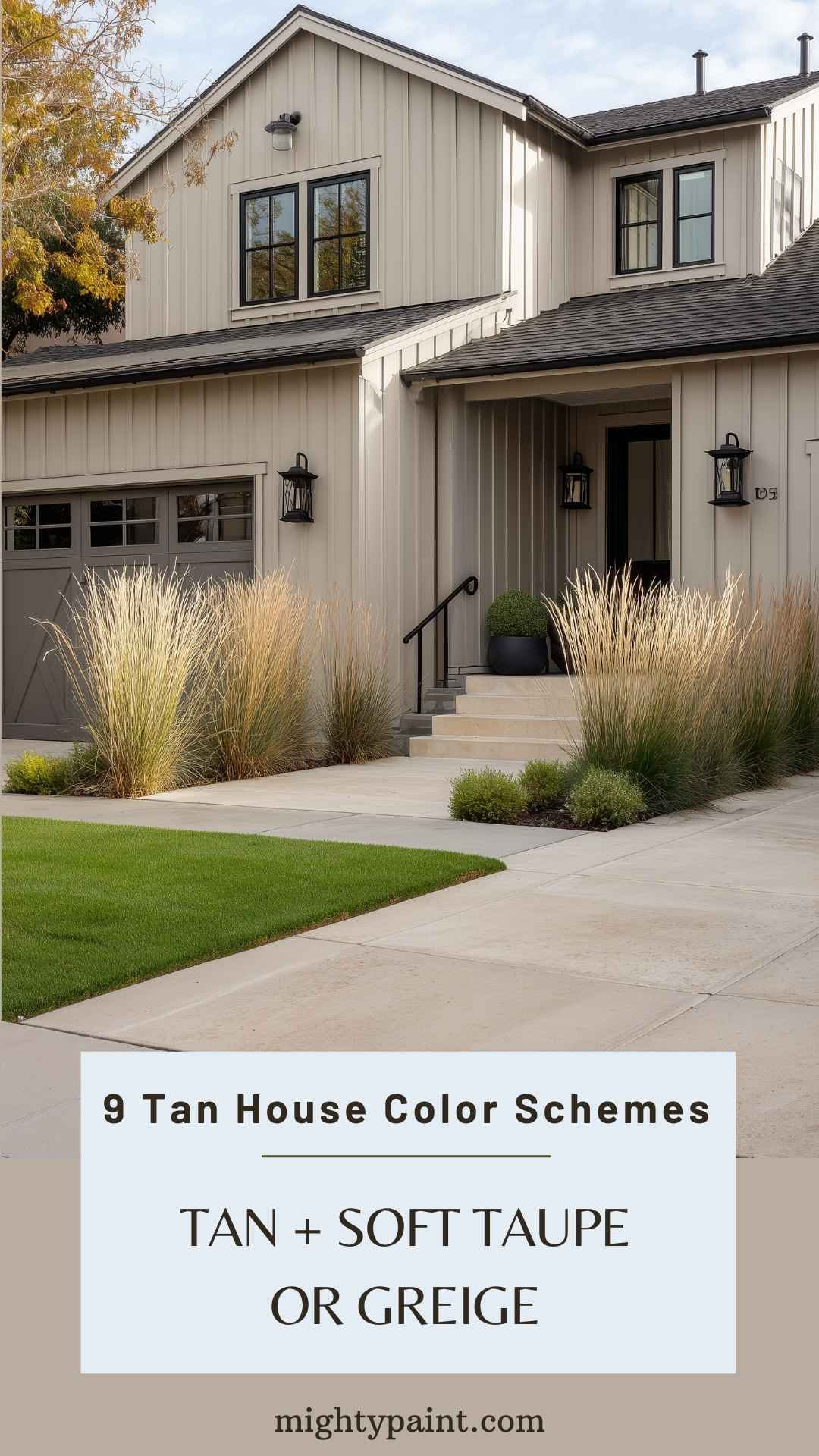
For a minimalist, upscale look, consider pairing tan with another neutral—like taupe or greige. This combination doesn’t rely on contrast but on layering and subtlety. When done right, it makes your home feel calm, collected, and architecturally polished.
Greige (a blend of grey and beige) works well with both warm and cool tans. The result is sophisticated and muted—ideal for homes with clean lines, contemporary detailing, or lots of texture (think board-and-batten siding or stucco).
Get the Fail-Safe Paint Color Playbook (Free PDF)
36 proven colors • 8 ready palettes • trim & sheen guide • printable testing cards.
Where It Works Best:
- Trim, fascia boards, and garage doors
- Gutters and downspouts
- Window frames and minimal shutters
Pair this palette with black light fixtures and concrete accents for a balanced modern aesthetic.
Visual Tip: Keep the greige within 2 LRV (light reflectance value) points of your tan for a tight, tonal blend.
8. Tan + Sage Green & Black Trim Combo
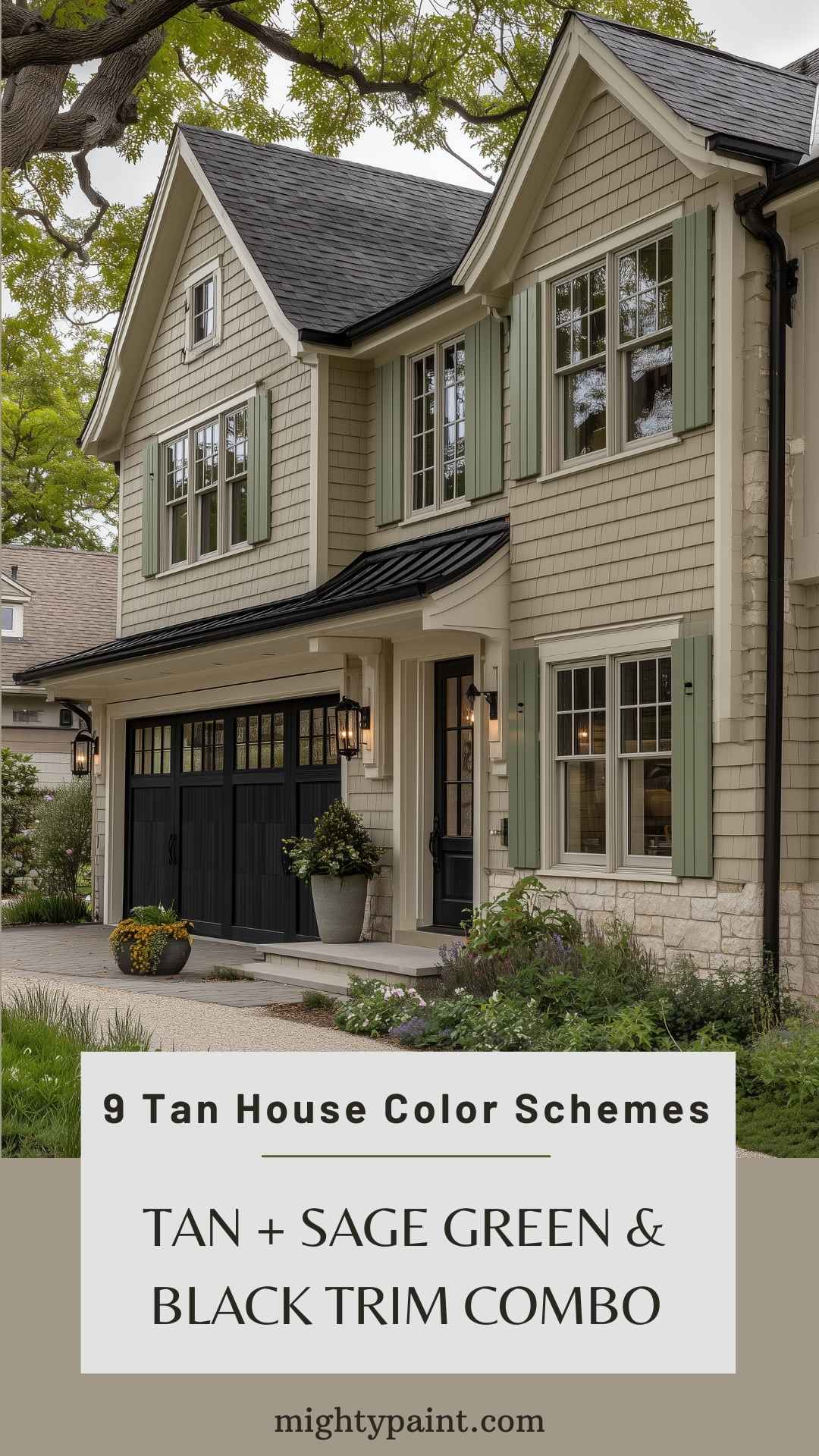
Want something layered and dimensional? Try using two accent colors instead of one. A soft sage green paired with subtle black trim creates a multi-tone palette that adds richness and structure to tan siding.
This look is perfect for homes with strong architectural lines—modern farmhouses, lodge-style cabins, or transitional suburban builds. The green softens, the black defines, and tan provides the perfect backdrop.
Application Ideas:
- Sage on shutters and porch ceiling
- Black window grids or garage trim
- Mix materials (stone base + wood accents) for depth
Use this scheme carefully: don’t let black overpower the softness of sage. Think balance, not contrast.
Harmony Tip: Keep black to small elements like trim, light fixtures, or hardware to avoid a heavy, blocky effect.
9. Tan + Marine Teal or Aqua Door
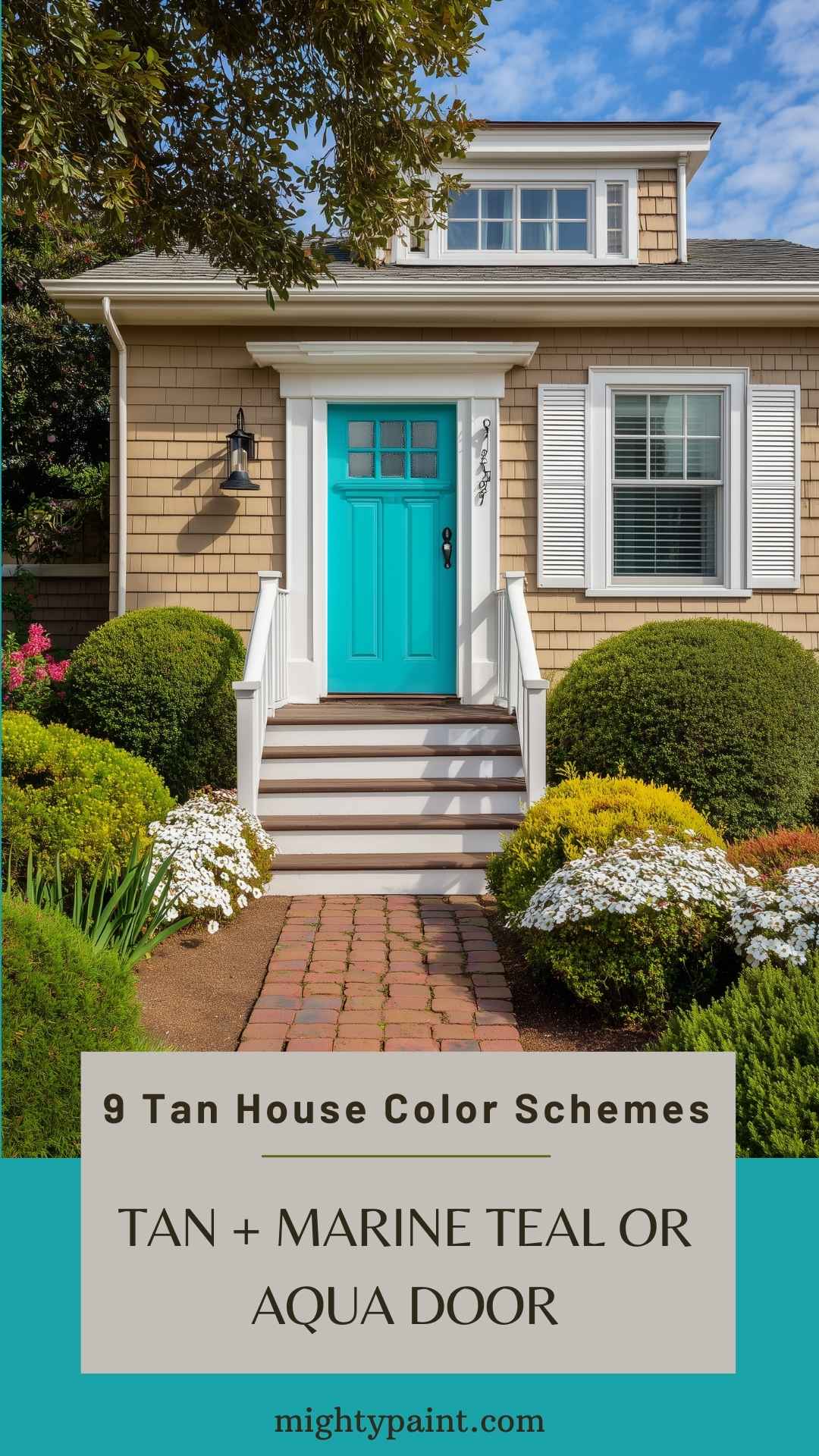
Sometimes, all you need is one bold move. A teal or aqua front door against tan siding creates an eye-catching focal point without overwhelming the rest of the exterior. It’s a small change with big impact—and it’s great for boosting curb appeal affordably.
This works especially well with lighter tans and neutral trims (like soft white or greige). Teal acts as a “pop” color—unexpected but stylish, especially on cottage-style homes or classic ranches.
Where to Try It:
- Front doors
- Garden gates or porch steps
- Planter boxes and accents
Balance the vibrancy with subtle surroundings. Let the door be the hero while the rest of the palette stays calm.
Bonus Tip: Teal plays well with potted greenery, natural stone, and white trim—making it a great choice if your front porch is framed with plants or columns.
Quick Styling & Material Tips
Accent colors matter, but supporting materials can make or break your color scheme. Think of your roof, stone details, and landscaping as part of your home’s color story. Here’s how to keep them in harmony with tan exteriors:
Complementing Roof Colors:
- Warm tan → brown, terracotta, or muted red roofing
- Cool tan → gray, charcoal, or slate blue roofing
- Neutral tan → can swing either way, depending on trim
Stone and Brickwork Pairings:
- Tan + warm stone (limestone, fieldstone) = rustic charm
- Tan + cool gray stone = modern balance
- Tan + red brick = classic, especially with white or black trim
Landscape Color Matching:
- Green foliage pairs well with nearly any tan
- Use bronze, black, or copper fixtures for hardware and lighting
- Consider seasonal plants that echo accent colors (like navy pots or rust-toned flowers)
Small details like mailbox color, walkway edging, and even garage doors can make your color scheme feel pulled together or pieced together. Use them wisely.
How to Test Without Commitment
The biggest mistake homeowners make? Committing to a color combo without seeing it in real life. Online samples and tiny paint chips don’t show you how a color behaves across full siding in daylight.
Get the Fail-Safe Paint Color Playbook (Free PDF)
36 proven colors • 8 ready palettes • trim & sheen guide • printable testing cards.
Here’s how to avoid regret:
- Paint large poster boards (18×24 inches or bigger) in your chosen tan and trim colors.
- Move them around your exterior walls and check how they look at different times of day.
- Leave them out after rain—colors often darken and reveal unexpected undertones in wet conditions.
And always test next to fixed features like brick, stone, and roof shingles. You want your paint to complement what’s already there—not compete with it. A weekend of testing can save you years of color regret.
Conclusion & Takeaway Checklist
Tan is more than just a “safe” exterior color—it’s a canvas full of opportunity. When paired with the right accents, it becomes stylish, warm, and timeless. But success lies in nuance and planning. Here’s your cheat sheet:
✅ Identify your tan’s undertone (warm, cool, or neutral)
✅ Choose accents that harmonize or create thoughtful contrast
✅ Keep accent color usage balanced—don’t let one tone dominate
✅ Coordinate roof, stone, and landscaping for a unified palette
✅ Always test large samples in real light before painting
Whether you want to add curb appeal or completely redefine your home’s personality, these tan house color schemes give you a reliable, beautiful starting point. Let tan do what it does best—anchor your exterior while letting accents shine.
